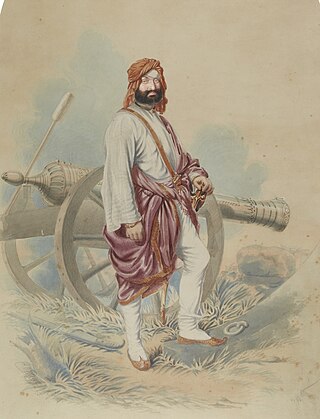
Guru Tegh Bahadur was the ninth of ten gurus who founded the Sikh religion and was the leader of Sikhs from 1665 until his beheading in 1675. He was born in Amritsar, Punjab, India in 1621 and was the youngest son of Guru Hargobind, the sixth Sikh guru. Considered a principled and fearless warrior, he was a learned spiritual scholar and a poet whose 115 hymns are included in the Guru Granth Sahib, which is the main text of Sikhism.
The following outline is provides an overview of Sikhism, or Sikhi.

Kangra-Lambagraon was a historical state and later princely estate (jagir) of British India located in the present-day state of Himachal Pradesh.

Shah Alam II, also known by his birth name Ali Gohar, or Ali Gauhar, was the seventeenth Mughal emperor and the son of Alamgir II. Shah Alam II became the emperor of a crumbling Mughal Empire. His power was so depleted during his reign that it led to a saying in the Persian language, Sultanat-e-Shah Alam, Az Dilli ta Palam, meaning, 'The empire of Shah Alam is from Delhi to Palam', Palam being a suburb of Delhi.

The Sikh Empire was a regional power based in the Punjab region of the Indian subcontinent. It existed from 1799, when Maharaja Ranjit Singh captured Lahore, to 1849, when it was defeated and conquered by the British East India Company in the Second Anglo-Sikh War. It was forged on the foundations of the Khalsa from a collection of autonomous misls. At its peak in the 19th century, the empire extended from Gilgit and Tibet in the north to the deserts of Sindh in the south and from the Khyber Pass in the west to the Sutlej in the east as far as Oudh. It was divided into four provinces: Lahore, which became the Sikh capital; Multan; Peshawar; and Kashmir from 1799 to 1849. Religiously diverse, with an estimated population of 4.5 million in 1831, it was the last major region of the Indian subcontinent to be annexed by the British Empire.
Anglo-Sikh War may refer to:

Gujranwala District, is a district that is a part of the Majha region in Punjab, Pakistan. Gujranwala District is bordered by the districts of Wazirabad, Sialkot, Hafizabad and Sheikhupura. Gujranwala district has 5 National Assembly and 12 Punjab Assembly constituencies. Gujranwala is known as the city of wrestlers and famous for its food.

The Kangra fort is a historic fort located in the Kangra district of the Himachal Pradesh state, India. This fort is also known as 'Nagarkot' and 'Kot Kangra'. This fort stands on a hillock between two rivers, among the foothills of the Dhauladhar range. This fort is the largest in the Indian Himalayas, and is under the protection of the Archeological Survey of India.

Raja Sher Singh Attariwala, OBI was a military commander and a member of the Sikh nobility during the Sikh Empire in the mid-19th century in Punjab, and later served under the British during the Revolt of 1857.
Prior to the arrival of the Mughals in the Indian subcontinent, the first instance of Islamic conquest of the region was during the 10th century when Mahmud Ghaznavi conquered Kangra. After the entry of the Mughals into the subcontinent, the region fell to Mughal authority as well. Later, due to internal conflicts within the Mughal dynasty the rulers of the hill provinces took complete advantage. Kangra regained its independence under Maharaja Sansar Chand who ruled for nearly 50 years. He was one of the most powerful administrators of the region. After he took the formal possession of Kangra fort, Maharaja Sansar Chand began to expand his territory. The states of Chamba, Suket, Mandi, and, Guler, Jaswan, Siba and Datarpur came under the direct control of Maharaja Sansar Chand.

Kahuta Tehsil is one of the seven tehsils (subdivisions) of Rawalpindi District in the Punjab province of Pakistan. The neighbouring tehsil of Kallar Sayedan used to be part of Kahuta, but was later created as separate tehsil. The name Kahuta was derived from "Koh" a local medicinal tree and "Boota".
Battle of Jalalabad may refer to:
The Battle of Rohilla, also known as the Battle of Hargobindpur, was a 1621 campaign by the Mughal Empire against the growing influence of the Sikhs.

The Sikh Rule in Lahore initiated from the conquest and rule of the Sikh Misls and extended till the Sikh Empire of Ranjit Singh which ended in 1849. The Sikhs began gaining power following the decline of the Mughal Empire in Punjab and consisted of a collection of autonomous Punjabi Misls, which were governed by Misldars, mainly in the Punjab region.
Battle of Delhi may refer to:
In Sikhism, dharamyudh, dharam-yudh or dharam yudh is a term which is variously translated as 'religious war', 'war of righteousness', 'war in defence of righteousness', or 'war for justice'. Though some core tenets in the Sikh religion are understood to emphasise peace and nonviolence, especially before the 1606 execution of Guru Arjan by Mughal emperor Jahangir, military force may be justified if all peaceful means to settle a conflict have been exhausted, thus resulting in a dharamyudh.
This page is based on this
Wikipedia article Text is available under the
CC BY-SA 4.0 license; additional terms may apply.
Images, videos and audio are available under their respective licenses.








